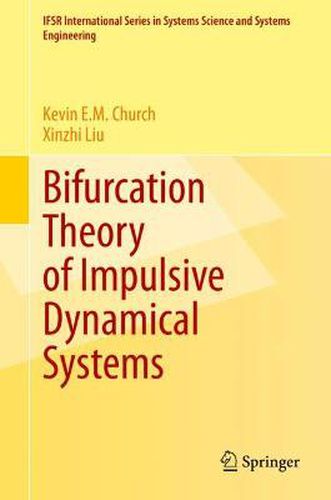Readings Newsletter
Become a Readings Member to make your shopping experience even easier.
Sign in or sign up for free!
You’re not far away from qualifying for FREE standard shipping within Australia
You’ve qualified for FREE standard shipping within Australia
The cart is loading…






This title is printed to order. This book may have been self-published. If so, we cannot guarantee the quality of the content. In the main most books will have gone through the editing process however some may not. We therefore suggest that you be aware of this before ordering this book. If in doubt check either the author or publisher’s details as we are unable to accept any returns unless they are faulty. Please contact us if you have any questions.
This monograph presents the most recent progress in bifurcation theory of impulsive dynamical systems with time delays and other functional dependence. It covers not only smooth local bifurcations, but also some non-smooth bifurcation phenomena that are unique to impulsive dynamical systems. The monograph is split into four distinct parts, independently addressing both finite and infinite-dimensional dynamical systems before discussing their applications. The primary contributions are a rigorous nonautonomous dynamical systems framework and analysis of nonlinear systems, stability, and invariant manifold theory. Special attention is paid to the centre manifold and associated reduction principle, as these are essential to the local bifurcation theory. Specifying to periodic systems, the Floquet theory is extended to impulsive functional differential equations, and this permits an exploration of the impulsive analogues of saddle-node, transcritical, pitchfork and Hopf bifurcations.
Readers will learn how techniques of classical bifurcation theory extend to impulsive functional differential equations and, as a special case, impulsive differential equations without delays. They will learn about stability for fixed points, periodic orbits and complete bounded trajectories, and how the linearization of the dynamical system allows for a suitable definition of hyperbolicity. They will see how to complete a centre manifold reduction and analyze a bifurcation at a nonhyperbolic steady state.
$9.00 standard shipping within Australia
FREE standard shipping within Australia for orders over $100.00
Express & International shipping calculated at checkout
This title is printed to order. This book may have been self-published. If so, we cannot guarantee the quality of the content. In the main most books will have gone through the editing process however some may not. We therefore suggest that you be aware of this before ordering this book. If in doubt check either the author or publisher’s details as we are unable to accept any returns unless they are faulty. Please contact us if you have any questions.
This monograph presents the most recent progress in bifurcation theory of impulsive dynamical systems with time delays and other functional dependence. It covers not only smooth local bifurcations, but also some non-smooth bifurcation phenomena that are unique to impulsive dynamical systems. The monograph is split into four distinct parts, independently addressing both finite and infinite-dimensional dynamical systems before discussing their applications. The primary contributions are a rigorous nonautonomous dynamical systems framework and analysis of nonlinear systems, stability, and invariant manifold theory. Special attention is paid to the centre manifold and associated reduction principle, as these are essential to the local bifurcation theory. Specifying to periodic systems, the Floquet theory is extended to impulsive functional differential equations, and this permits an exploration of the impulsive analogues of saddle-node, transcritical, pitchfork and Hopf bifurcations.
Readers will learn how techniques of classical bifurcation theory extend to impulsive functional differential equations and, as a special case, impulsive differential equations without delays. They will learn about stability for fixed points, periodic orbits and complete bounded trajectories, and how the linearization of the dynamical system allows for a suitable definition of hyperbolicity. They will see how to complete a centre manifold reduction and analyze a bifurcation at a nonhyperbolic steady state.